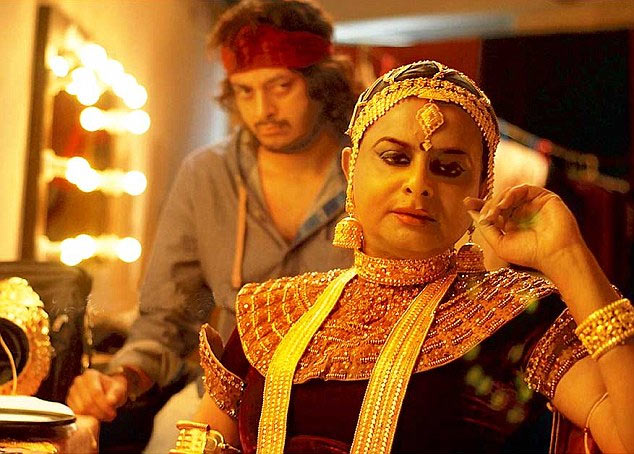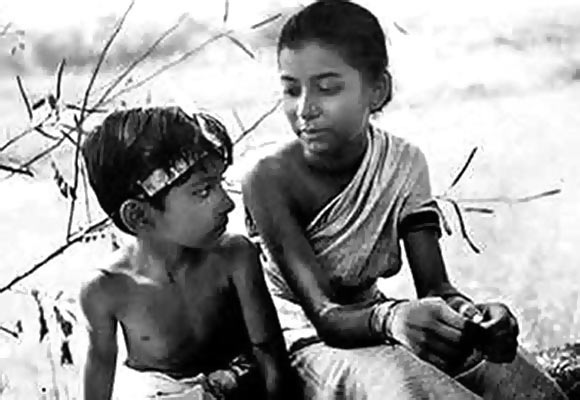Digbijay Mishra and Debaleena Sengupta in New Delhi
After Satyajit Ray died and Mrinal Sen retired, Bengali cinema was no longer what it used to be -- until Rituparno Ghosh triggered its revival.
Rituparno Ghosh, the auteur who brought the Bengali middle-class back to cinema halls, died recently.
In his 21-year career, it's easy to quantify what he earned -- 11 national awards in the best film category. But what he gave his audience is far more, a renaissance of sorts.
Ghosh's entry into Bengali cinema came at a time when Satyajit Ray was long gone and Mrinal Sen had retired from active film making. Commercial and masala films were the order of the day. What was once an industry that a discerning audience always kept an eye on had slipped.
In this depressing scene arrived Unishe April, Ghosh's film starring Aparna Sen and Prosenjit Chatterjee which went on to win the national award for best feature film. It struck an immediate chord with the Bengali audience who soon labelled Ghosh as its new-age Satyajit Ray. A self-confessed Ray fan, Ghosh was heavily inspired by the legendary director and his works bore Ray's imprint, bridging the gap between parallel and mainstream cinema.
Unishe April was the first Bengali movie to be screened at Priya, a single-screen hall in a predominantly Bengali residential area of Kolkata. Until then, Priya cinema had been banking on Bollywood films to keep it going.
"Ghosh was responsible for bringing Bengali urban audiences back to the movie halls at a time when Bengali commercial movies were being dubbed as the 'rural man's entertainment'. His films changed the perspective of Bengali cinema," says Arijit Dutta, managing director of Priya Entertainments and former president of Eastern India Motion Pictures Association.
Ghosh is dead. But others have taken over from where he left.
There is a whole breed of new film makers today which is experimenting with new subjects, treatment and casting, essentially appealing to urban sensibilities. Films like Bhooter Bhabishyat, Ami Aar Amar Girlfriends and Maach Mishti & More are a result of this trend.
The themes are often whacky. For instance, director Anik Dutta's debut film, Bhooter Bhabishyat, is a satire about a gang of ghosts living in an old palatial mansion of north Kolkata soon to be broken down for a luxury mall. It is the story of how they confront the situation. The film, which had a record run at the box office and hogged the editorial pages for days, is now set for a Bollywood remake.
Dutta, who comes from an advertising background, says that a great deal of the film's success was through word of mouth. "As a director, I tried to be true to myself and made sure that I enjoyed the script. I was humbled when audience across the spectrum appreciated my film," he says.
Rituparno Ghosh drew Bengali audience back into the folds
Image: Subir Roy and Uma Dasgupta in a scene from Pather PanchaliIndeed the Tollygunge cine industry, popularly called studio para, was the hub of both commercial and art films with names like Asit Sen and Ajay Kar giving blockbuster commercial hits like Deep Jwele Jai, Uttar Falguni, Harano Sur and Saat Paake Bandha with actors like Uttam Kumar, Suchitra Sen and Soumitra Chatterjee as the protagonists dealing with the concerns of the then Anglicised society.
On the other hand, film makers like Ritwik Ghatak and Ray tried to break the monotony with parallel cinema that had a distinct storyline and narrative.
One of Ghatak's earliest films, Ajantrik in 1958, was a comic fiction about an inanimate object, a motor car, as a character in the story. Though not a commercial success - and Ghatak was not known for delivering box office hits - his later movies, Meghe Dhaka Tara (The Cloud-Capped Star, 1960), Komal Gandhar (1961), and Subarnarekha (Golden Lining, 1965) dealt with serious subjects such as the condition of Partition refugees.
Pather Panchali (1955), by Ghatak's contemporary Ray, was based on a classic Bengali novel by Bibhutibhushan Bandopadhyay and was critically acclaimed. Mrinal Sen, the other maestro in the troika, gave films like Kharij and Akaler Sandhane starring Bollywood actor Smita Patel which became landmarks in parallel cinema.
But by the late 1980s, with the advent of television, Bengali audience started visiting cinema halls far less.
The divide between commercial movies and a distinct genre of films dealing with urban sensibilities by directors like Ghosh and Aparna Sen grew intense. And then, it was a chicken and egg situation. It suddenly made more economic sense to target smaller towns and churn out masala movies.
It took Rituparno Ghosh to draw the Bengali audience back into the folds with meaningful cinema.
'Pushing filmmakers to cater to small towns does not work in the long run'
Image: Parno Mitra, Raima Sen and Swastika Mukherjee in Ami Aar Amar GirlfriendsNow there is a new crop of directors which is targeting the 'multiplex audiences'. Consider this scene from a Mainak Bhowmick film: three girls in bikinis frolicking by the beach. The scene is from Ami Aar Amar Girlfriends -- a film about female bonding (no, not lesbianism) -- which created quite a stir with its unusual theme.
"I make films about Kolkata, more specifically about south Kolkata, right here, right now. Small-town audiences might not be receptive to my films," admits Bhowmick whose three films -- Bedroom, Maach Mishti & More and Ami Aar Amar Girlfriend - dealt with urban characters and issues.
There is no denying that there is a divide between urban and small-town audience, says Bhowmick. "Pushing film makers to cater to small towns does not work in the long run. The concept that new-generation film makers are trying to portray might be in conflict with the conservative, middle-class sentiments," he adds. Bhowmick says he is happy when his films run successfully in 30-40 cinemas across the city.
"I think earlier making these experimental films was tougher - both technically and economically. Now many producers are coming forward to back films like Bhooter Bhabishyat," says Pradip Sarkar, director of Parineeta.
Sarkar feels that audiences crave for sensible stories and that is why more Bengali films of every genre are being screened at multiplexes. "The trend is national," he says.
"Bengal," says Mahesh Ramanathan, COO, Reliance Entertainment, "still is primarily a theatrical market which generates the biggest chunk of revenues from films. Efforts are on to create a global market for Bengali films which would make their reach much bigger."
Septuagenarian actor Soumitra Chatterjee, the protagonist of several of Ray's movies, welcomes this change in Bengali cinema. "The industry has recovered from the vicious pattern of blindly aping south Indian films. Now we are looking at new subjects, but there is monotony in that as well," he says.
Jean Luc-Godard had once said: "The auteur is dead. The future is cut-and-paste movie mash-ups." Hopefully, Bengali cinema will do better.





Comment
article